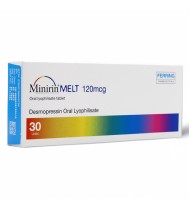Desmopressin Acetate
Indications
Desmopressin Acetate sublingual tablet is indicated for the treatment of-
- Primary Nocturnal Enuresis
- Nocturia and
- Central Diabetes Insipidus
Pharmacology
By mimicking the actions of endogenous ADH, desmopressin acts as a selective agonist of V2 receptors expressed in the renal collecting duct (CD) to increase water re-absorption and reduce urine production. Desmopressin has been shown to be more potent than ADH in increasing plasma levels of factor VIII activity in patients with hemophilia and von Willebrand's disease Type I. Desmopressin demonstrates markedly diminished pressor activity. Desmopressin administered intranasally has an antidiuretic effect about one-tenth that of an equivalent dose administered by injection.
Upon binding of desmopressin to V2 receptors in the basolateral membrane of the cells of the distal tubule and collecting ducts of the nephron, adenylyl cyclase is stimulated. The resulting intracellular cascades in the collecting duct lead to increased rate of insertion of water channels, called aquaporins, into the lumenal membrane and enhanced the permeability of the membrane to water.
Upon binding of desmopressin to V2 receptors in the basolateral membrane of the cells of the distal tubule and collecting ducts of the nephron, adenylyl cyclase is stimulated. The resulting intracellular cascades in the collecting duct lead to increased rate of insertion of water channels, called aquaporins, into the lumenal membrane and enhanced the permeability of the membrane to water.
Dosage
Treatment of diabetes insipidus: Dosage is individual in diabetes insipidus but the total daily sublingual dose normally lies in the range of 120 micrograms to 720 micrograms. A suitable starting dose in adults and children is 60 micrograms three times daily, administered sublingually. This dosage regimen should then be adjusted in accordance with the patient's response. For the majority of patients, the maintenance dose is 60 micrograms to 120 micrograms sublingually three times daily.
Post-hypophysectomy polyuria/polydipsia: The dose of Desmopressin Acetate Melt should be controlled by measurement of urine osmolality.
Post-hypophysectomy polyuria/polydipsia: The dose of Desmopressin Acetate Melt should be controlled by measurement of urine osmolality.
Administration
Desmopressin Acetate Melt is for sublingual use.
Interaction
Substances which are known to induce SIADH e.g. tricyclic antidepressants, selective serotonin re-uptake inhibitors, chlorpromazine and carbamazepine, may cause an additive antidiuretic effect leading to an increased risk of water retention and/or hyponatraemia. NSAIDs may induce water retention and/or hyponatraemia. Concomitant treatment with loperamide may result in a 3-fold increase of desmopressin plasma concentrations, which may lead to an increased risk of water retention and/or hyponatraemia. Although not investigated, other drugs slowing intestinal transport might have the same effect. A standardised 27% fat meal significantly decreased the absorption (rate and extent) of a 0.4mg dose of oral desmopressin tablets. Although it did not significantly affect the pharmacodynamic effect (urine production and osmolality), there is the potential for this to occur at lower doses. If a diminution of effect is noted, then the effect of food should be considered before increasing the dose.
Contraindications
Desmopressin Acetate Melt is contraindicated in cases of cardiac insufficiency and other conditions requiring treatment with diuretic agents. Before prescribing Desmopressin Acetate Melt, the diagnoses of psychogenic polydipsia and alcohol abuse should be excluded.
Side Effects
Side-effects include headache, stomach pain and nausea. Isolated cases of allergic skin reactions and more severe general allergic reactions have been reported. Very rare cases of emotional disorders including aggression in children have been reported. Treatment with desmopressin without concomitant reduction of fluid intake may lead to water retention/hyponatraemia with accompanying symptoms of headache, nausea, vomiting, weight gain, decreased serum sodium and in serious cases, convulsions.
Pregnancy & Lactation
Pregnancy: Data on a limited number (n=53) of exposed pregnancies in women with diabetes insipidus indicate rare cases of malformations in children treated during pregnancy. To date, no other relevant epidemiological data are available. Animal studies do not indicate direct or indirect harmful effects with respect to pregnancy, embryonal/fetal development, parturition or postnatal development. Caution should be exercised when prescribing to pregnant women. Blood pressure monitoring is recommended due to the increased risk of pre-eclampsia.
Lactation: Results from analyses of milk from nursing mothers receiving high dose desmopressin (300 micrograms intranasally) indicate that the amounts of desmopressin that may be transferred to the child are considerably less than the amounts required to influence diuresis.
Lactation: Results from analyses of milk from nursing mothers receiving high dose desmopressin (300 micrograms intranasally) indicate that the amounts of desmopressin that may be transferred to the child are considerably less than the amounts required to influence diuresis.
Precautions & Warnings
Care should be taken with patients who have reduced renal function and/or cardiovascular disease. In chronic renal disease the antidiuretic effect of Desmopressin Acetate Melt would be less than normal. Precautions to prevent fluid overload must be taken in:
- conditions characterised by fluid and/or electrolyte imbalance.
- patients at risk for increased intracranial pressure.
Overdose Effects
An overdose of Desmopressin Acetate Melt leads to a prolonged duration of action with an increased risk of water retention and/or hyponatraemia. Although the treatment of hyponatraemia should be individualised, the following general recommendations can be given. Hyponatraemia is treated by discontinuing the desmopressin treatment, fluid restriction and symptomatic treatment if needed.
Therapeutic Class
Synthetic analogue of ADH
Storage Conditions
Store in the original package in order to protect from moisture and light.
Minirin Melt Sublingual Tablet 120 mcg
IndicationsDesmopressin Acetate sublingual tablet is indicated for the treatment of-Primary Nocturna..
90.00Tk.
Minirin Melt Sublingual Tablet 60 mcg
IndicationsDesmopressin Acetate sublingual tablet is indicated for the treatment of-Primary Nocturna..
53.00Tk.
Showing 1 to 2 of 2 (1 Pages)


